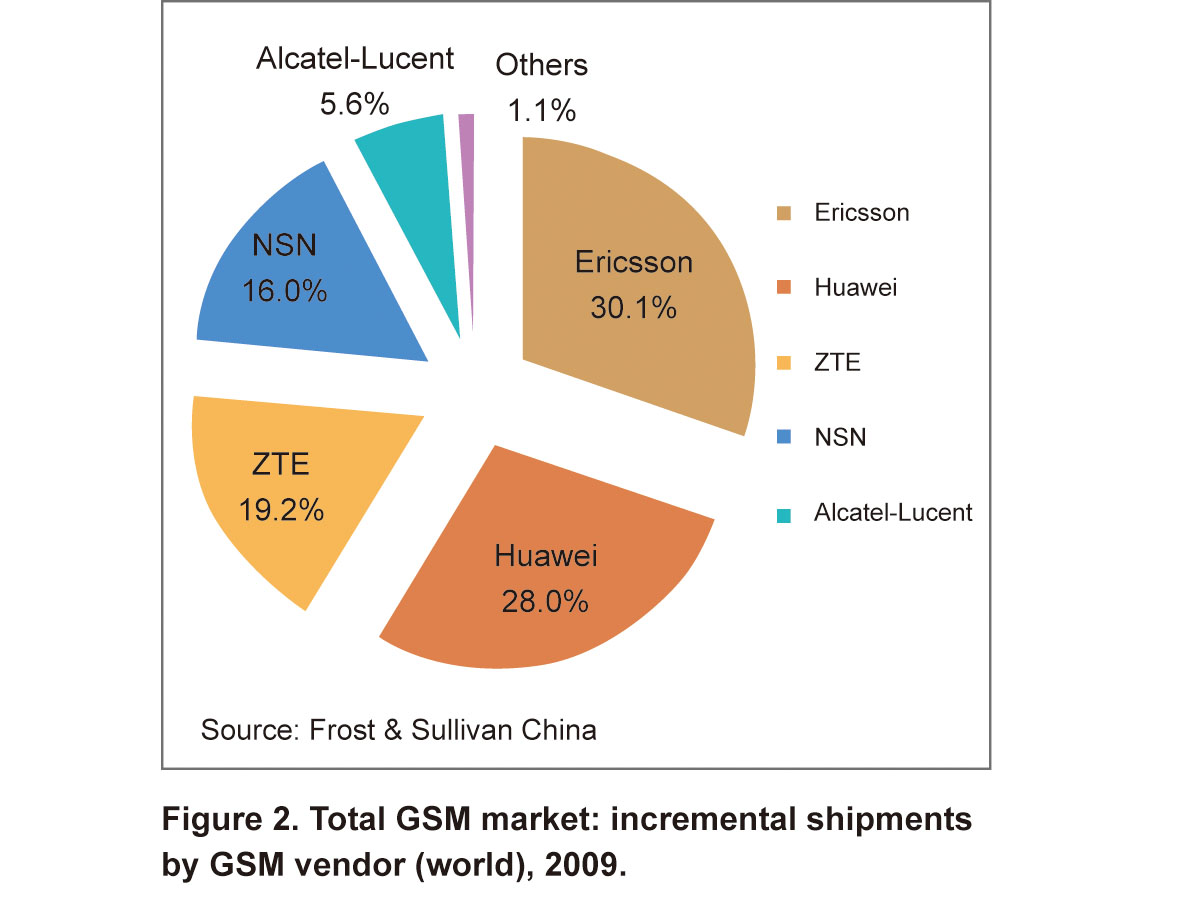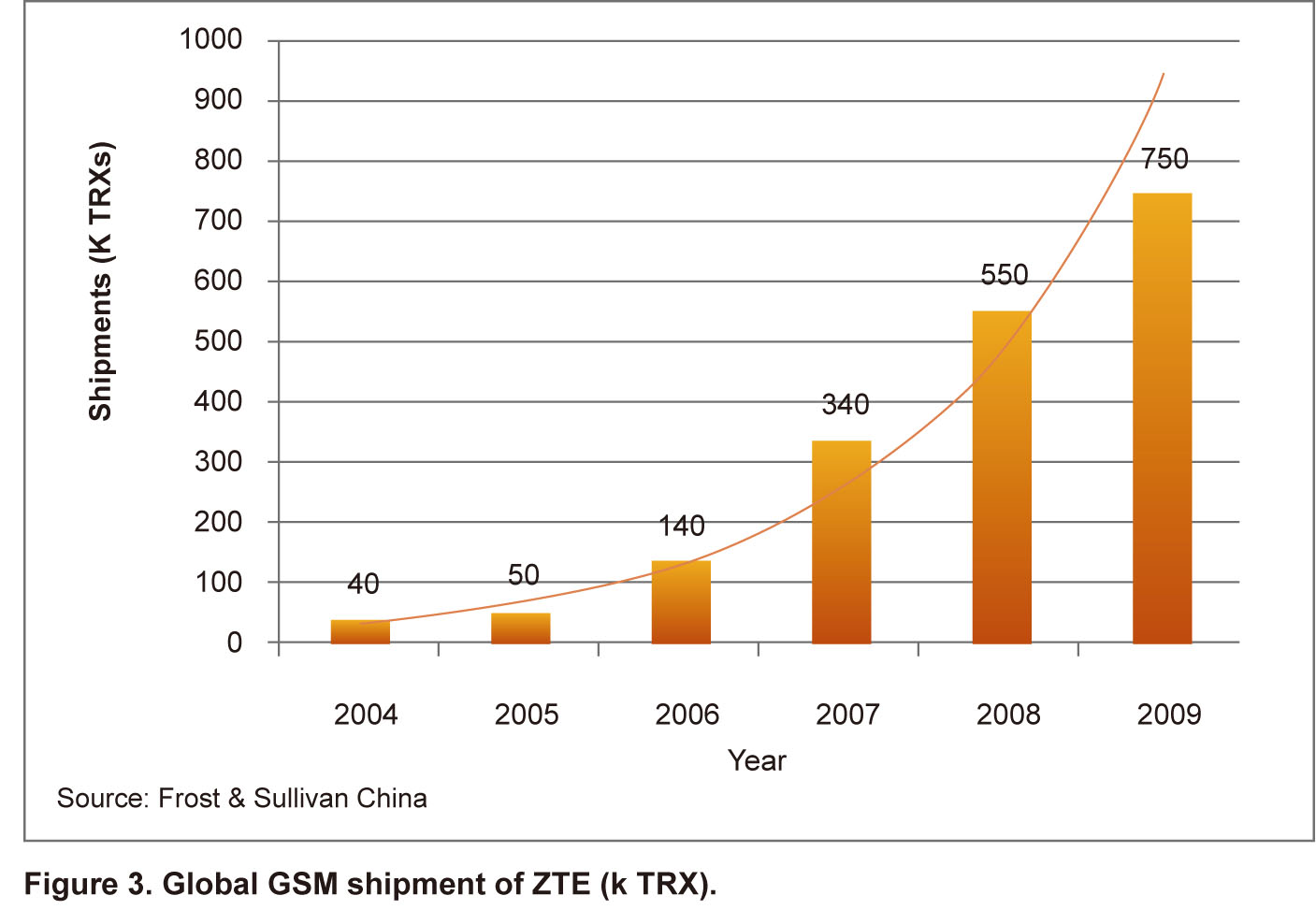Global GSM Incremental Market Analysis
Overview of Global GSM Market
Global GSM market development
GSM continues to drive mobile subscriptions’ growth in major markets. Global GSM accounts for 83.5% of global mobile subscribers and this preponderant proportion has retained for a long time. The scale economies effect of GSM could not be changed till 2014. With the rich application of 3G, the share of GSM subscribers is likely to decrease to 56.4% by the end of 2013.
Traditional GSM equipment providers, such as Ericsson, NSN, and ALU, dominate mature market. Asia Pacific and Europe are the largest markets for GSM, both in terms of equipment and subscribers.
From the technological perspective, global GSM networks operate in a number of different frequency ranges (classified as GSM frequency ranges for 2G and UMTS frequency bands for 3G). Most 2G GSM networks operate in the 900MHz or 1,800MHz bands. North American countries (including Canada and the United States) use the 850MHz and 1,900MHz bands, because the 900MHz and 1,800MHz frequency bands were already allocated. Most 3G GSM networks in Europe operate in the 2,100MHz frequency band.
GSM market development in major regions
Europe
Europe was the first to develop and launch GSM, and currently enjoys its widest applications. It should be noted that mobile carriers perform very differently in the licensed markets of western Europe, despite similar framework conditions on both the supply and demand sides. For example, top five UK GSM carriers are 3 UK, Orange, T-Mobile, Telefonica O2, and Vodafone.
GSM subscriber base in the United Kingdom is still increasing, and the number of total subscribers is likely to increase from 75.9 million in 2008 to 78.0 million in 2010, with wireless penetration expected to reach 126% in 2010.
China
At the beginning of 2009, 3G licenses were issued to three main carriers in China. By the end of 2009, China had 67.3% of mobile penetration rate. With a population of 1.34 billion, China’s mobile market looks promising for the next three years.
India
India is one of the most important GSM markets at present, and nearly all of the top GSM equipment providers are focusing on this emerging market. GSM mobile carriers in India added 9.32 million new subscribers in June 2009, which is a good improvement over the 8.93 million subscribers added in April 2009. The strength of different Indian GSM carriers vary significantly, the total market share of top three GSM carriers reaches 67% of the total market.
Competitive Analysis of GSM Incremental Market in 2009
Market share analysis of global GSM incremental market
As seen in Figure 1, global GSM shipments increased from 2,600k TRXs to 3,438k TRXs, with 5.5% yearly growth rate. Although the GSM shipments in 2008 and 2009 were less than before, the overall GSM market was growing in the last five years. It can be expected that the GSM shipments will continue to rise in next four to five years.

Traditional GSM equipment providers, such as Ericsson and NSN, gradually compete in more mature markets for better profitability. As competitive telecommunication equipment vendors, Huawei and ZTE have been growing and building their presence in emerging and mature markets with innovative products and network delivery capacity.
In the mature market, GSM carriers have been providing 3G service for several years. The market is characterized by fierce competition and increased demand for data services from subscribers. Apart from looking for new customers, retaining existing GSM customers for carriers in mature market is also important. In Western Europe, as a mature market, and GSM carriers are looking at value-added services through better groups of killer applications. Mature market is considered as saturated market, especially in Western Europe, where GSM carriers are constantly looking for new ways to differentiate themselves from their competitors.
In the emerging market, GSM continues to promote mobile subscriptions growth, with market share rising by the end 2007 in Brazil to 76.5% (63.1% in end-2006), in China 91.9% (91.5% in end-2006), in India 78.9% (76.7% in end-2006) and in Russia 99.3% (99.1% in end-2006).

As seen in Figure 2, the incremental GSM markets experienced significant changes, while emerging providers, such as Huawei and ZTE, increased their market shares by the end of 2009, and traditional providers, such as Ericsson, NSN, Alcatel-Lucent did not register much growth in market share.
Case study of emerging equipment providers
Under current market scenario, emerging providers such as Huawei and ZTE display great competitive strength, as their R&D and manufacturing activities are centered in the developing countries and they undertake flexible localized operation. Thus, they are poised to get much more shares in the newly added markets and are to enter the high-end market.
For example, ZTE shows about 120% growth rate per year from 2005 to 2009 and shipped 750,000 TRXs in 2009 (see Figure 3). ZTE is partnering with industry-leading carriers including China Mobile, China Unicom, Reliance, Etisalat, Telenor, Telstra, Teliasonera, Singtel, Sonaecom and Hutchison.

ZTE’s GSM products have been in more than 70 countries and regions, more than 100 network operators to deploy. ZTE is serving 420 million subscribers worldwide.
With deployment of first All-IP commercial SDR GSM network in Hong Kong, ZTE has completed 200,000 units shipped, as well as high performance and low TCO of the green network delivery by the end of October in 2009.
In 2009, ZTE generated 19.2% market share of incremental market.
GSM Market Forecasts and Opportunity Analysis
GSM market forecasts
■ On the basis of a large number of global subscribers, global GSM market will have 500 million subscribers by the end of 2010.
■ In mature market, GSM carriers have been providing 3G service for several years, and this market is likely to grow slowly.
■ Most of competitions will be experienced in emerging market, such as China, India, and African countries.
■ With regard to Asia Pacific, mobile subscriber base is likely to increase at a stable rate by 2013; as a result, there will be stable demand for GSM device by 2012.
■ In Latin America, mobile subscribers are expected to reduce further in number as the market shifted from CDMA to GSM.
■ The GSM device price is likely to drop continually and professional maintenance services are expected to gradually gain importance. In particular, GSM carriers will emphasize on complete design ability and provision of customized maintenance services, especially for data business operations.
GSM market opportunity analysis
In future, key GSM market opportunities will focus on two aspects. First of all, more emphasis will be laid on the undeveloped markets. Second, the mainstream GSM carriers, especially the EDGE and LTE revolution, will provide increased opportunities.
With respect to GSM market opportunities, following is likely to come true in next four to five years:
■ Compared to the transition from GSM to LTE, the transition from GSM to EDGE would be smoother and less expensive, as most of the mobile subscribers are using GSM and a majority of them do not want to change their phone numbers or phones immediately.
■ In the high-end market of developed countries, Huawei and ZTE are taking advantages of low-cost and customized applications to seek market opportunities and demonstrate their competitive strength.
■ In the low-end market of the developing countries, the emerging providers, Huawei and ZTE have many advantages, including localized operation, customized invention, and relatively low TCO. They are likely to seek more market opportunities and demonstrate their competitive strength.
■ Emerging markets, such as China, India, and African countries, are likely to witness an incremental trend of capacity expansion of GSM and EDGE application.
■ Value-added services will attract more subscribers’ attention; primary GSM carriers are accumulating more technologies and capitals to strengthen their profitability.
■ Implementation of innovative technologies such as multi-mode & smooth evolution, energy saving methods, and all IP networking systems drive the GSM market. As one of the few telecom equipment and network solution providers in the industry at present with SDR-based stations that supports these technologies, ZTE shows high competitive strength and is to become one of the top three providers of global GSM incremental market in future.